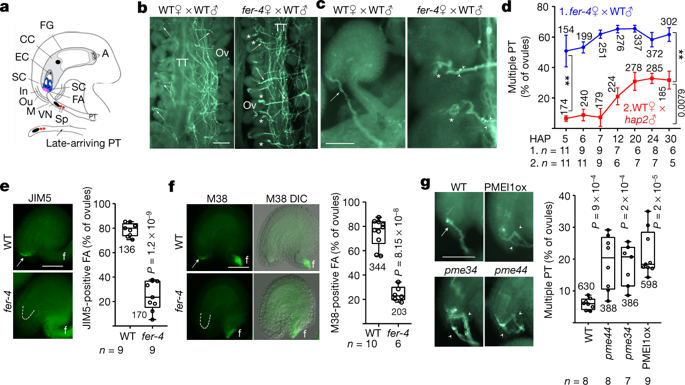Nature ( IF 50.5 ) Pub Date : 2020-03-18 , DOI: 10.1038/s41586-020-2106-2 Qiaohong Duan , Ming-Che James Liu , Daniel Kita , Samuel S. Jordan , Fang-Ling Jessica Yeh , Robert Yvon , Hunter Carpenter , Anthony N. Federico , Liliana E. Garcia-Valencia , Stephen J. Eyles , Co-Shine Wang , Hen-Ming Wu , Alice Y. Cheung

|
Species that propagate by sexual reproduction actively guard against the fertilization of an egg by multiple sperm (polyspermy). Flowering plants rely on pollen tubes to transport their immotile sperm to fertilize the female gametophytes inside ovules. In Arabidopsis, pollen tubes are guided by cysteine-rich chemoattractants to target the female gametophyte1,2. The FERONIA receptor kinase has a dual role in ensuring sperm delivery and blocking polyspermy3. It has previously been reported that FERONIA generates a female gametophyte environment that is required for sperm release4. Here we show that FERONIA controls several functionally linked conditions to prevent the penetration of female gametophytes by multiple pollen tubes in Arabidopsis. We demonstrate that FERONIA is crucial for maintaining de-esterified pectin at the filiform apparatus, a region of the cell wall at the entrance to the female gametophyte. Pollen tube arrival at the ovule triggers the accumulation of nitric oxide at the filiform apparatus in a process that is dependent on FERONIA and mediated by de-esterified pectin. Nitric oxide nitrosates both precursor and mature forms of the chemoattractant LURE11, respectively blocking its secretion and interaction with its receptor, to suppress pollen tube attraction. Our results elucidate a mechanism controlled by FERONIA in which the arrival of the first pollen tube alters ovular conditions to disengage pollen tube attraction and prevent the approach and penetration of the female gametophyte by late-arriving pollen tubes, thus averting polyspermy.
中文翻译:

FERONIA 控制果胶和一氧化氮介导的男女互动
通过有性生殖繁殖的物种积极防止多个精子(多精症)使卵子受精。开花植物依靠花粉管运输其不动的精子,使胚珠内的雌配子体受精。在拟南芥中,花粉管由富含半胱氨酸的化学引诱剂引导,以靶向雌性配子体1,2。FERONIA 受体激酶在确保精子输送和阻断多精症3方面具有双重作用。此前有报道称,FERONIA 会产生一个雌性配子体环境,这是精子释放4所必需的。在这里,我们表明 FERONIA 控制了几个功能相关的条件,以防止雌性配子体被多个花粉管穿透。拟南芥。我们证明了 FERONIA 对于维持丝状器官(雌配子体入口处的细胞壁区域)的去酯化果胶至关重要。花粉管到达胚珠会触发一氧化氮在丝状器官中的积累,该过程依赖于 FERONIA 并由去酯化果胶介导。一氧化氮亚硝酸盐是趋化剂 LURE1 的前体形式和成熟形式1,分别阻断其分泌和与其受体的相互作用,以抑制花粉管的吸引力。我们的研究结果阐明了一种由 FERONIA 控制的机制,其中第一个花粉管的到来改变了卵子的条件,从而解除了花粉管的吸引力,并阻止了迟到的花粉管接近和穿透雌性配子体,从而避免了多精症。











































 京公网安备 11010802027423号
京公网安备 11010802027423号